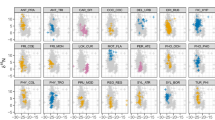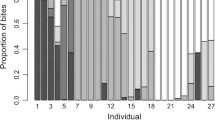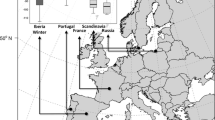Abstract
Throughout their annual cycle, migrants often adopt different foraging and microhabitat usage strategies. Previous studies treat migrants as niche-trackers/niche-followers, i.e., they track similar niches along their annual cycle, almost exclusively based on food resource availability, which is inferred based on the climate at either the wintering or breeding grounds. An alternative approach is the use of such techniques as stable isotope analyses that allow researchers to more directly infer a migrant’s niche across seasons. While the use of carbon isotopes enables an assessment of microhabitat traits, that of nitrogen isotopes provides information on a bird’s trophic level. In the study reported here, we performed comparative analyses of stable carbon and nitrogen isotope ratios in tissues of the resident Plain-crested Elaenia and the intratropical migrant Lesser Elaenia to evaluate their year-round ecological niches. Our data suggest that both residents and migrants were consistent in their use of similar microhabitats throughout the year, which indicates a niche-tracking behavior on the part of migratory individuals. Migrants often fed at higher trophic levels than residents, but both species exhibited similar trophic level shifts through the year, feeding on higher trophic levels during breeding and on the lowest ones while wintering. The observed patterns could be due to several factors, including differential energetic demand needed for the migratory journey, species-specific nutritional needs during each stage of the year, and/or the use of multiple wintering grounds by migrants.
Zusammenfassung
Abweichende Jahreszyklen eines innertropischen Zugvogels und eines tropischen Standvogels
Im Verlauf ihres Jahreszyklus verfolgen Zugvögel häufig unterschiedliche Strategien bei der Nahrungssuche und in der Wahl des Mikrohabitats. In früheren Untersuchungen wurden Zugvögel als Nischenfolger behandelt, d. h. sie folgen im Jahresverlauf ähnlichen ökologischen Nischen, fast ausschließlich aufgrund der Verfügbarkeit von Nahrungsressourcen, auf welche anhand des Klimas in Überwinterungs- beziehungsweise Brutgebieten geschlossen wurde. Alternativ erlauben es Techniken wie die Analyse stabiler Isotope, auf eine direktere Weise auf die von einem Zugvogel im Verlauf der Jahreszeiten besetzten Nischen zu schließen. Während Kohlenstoffisotope eine Einschätzung der Mikrohabitateigenschaften ermöglichen, liefern Stickstoffisotope Informationen über die Trophieebene eines Vogels. In dieser Studie führten wir vergleichende Analysen der Verhältnisse stabiler Kohlenstoff- und Stickstoffisotope an Gewebeproben des Braunscheitel-Olivtyranns Elaenia cristata, eines Standvogels, sowie des innertropisch ziehenden Grauwangen-Olivtyranns Elaenia chiriquensis durch, um deren ökologische Nischen im Jahresverlauf auszuwerten. Unsere Daten legen nahe, dass sowohl die ortsansässigen Standvögel als auch die Durchzügler gleichbleibend das ganze Jahr über ähnliche Mikrohabitate nutzten, was auf ein Nischenfolger-Verhalten bei den ziehenden Individuen hindeutet. Die Zugvögel befanden sich bei der Nahrungssuche oft auf höheren Trophieebenen als die Standvögel, aber beide Arten zeigten ähnliche Verschiebungen der Trophieebene im Jahreslauf, indem sie zur Brutzeit auf höheren Trophieebenen nach Nahrung suchten und beim Überwintern die niedrigsten einnahmen Den beobachteten Mustern könnten verschiedene Faktoren zugrunde liegen, darunter ein abweichender Energiebedarf auf dem Zugweg, artspezifische Nährstoffansprüche zu jeder Phase im Jahreslauf sowie die Nutzung multipler Überwinterungsgebiete durch Zugvögel.


Similar content being viewed by others
References
Anderson DR (2010) Model based inference in the life sciences: a primer on evidence. Springer SBM, New York
Anderson DR, Burnham KP (2002) Avoiding pitfalls when using information-theoretic methods. J Wildl Manag 66:912–918
Anderson DR, Link WA, Johnson DH, Burnham KP (2001) Suggestions for presenting the results of data analyses. J Wildl Manag 65:373–378
Auerswald K, Wittmer MHOM, Zazzo A, Schäufele R, Schnyder H (2010) Biases in the analysis of stable isotope discrimination in food webs. J Appl Ecol 47:936–941. doi:10.1111/j.1365-2664.2009.01764.x
Bairlein F et al (2012) Cross-hemisphere migration of a 25 g songbird. Biol Lett. doi:10.1098/rsbl.2011.1223
Bates D, Maechler M, Bolker B (2012) lme4: linear mixed-effects models using S4 classes R package version 0999375-42. R Foundation for Statistical Computing, Vienna
Bearhop S, Waldron S, Votier SC, Furness RW (2002) Factors that influence assimilation rates and fractionation of nitrogen and carbon stable isotopes in avian blood and feathers. Physiol Biochem Zool 75:451–458
Bearhop S, Furness RW, Hilton GM, Votier SC, Waldron S (2003) A forensic approach to understanding diet and habitat use from stable isotope analysis of (avian) claw material. Funct Ecol 17:270–275
Bridge ES, Thorup K, Bowlin MS et al (2011) Technology on the move: recent and forthcoming innovations for tracking migratory birds. Bioscience 61:689–698. doi:10.1525/bio.2011.61.9.7
Burnham KP, Anderson DR, Huyvaert KP (2011) AIC model selection and multimodel inference in behavioral ecology: some background, observations, and comparisons. Behav Ecol Sociobiol 65:23–35. doi:10.1007/s00265-010-1029-6
Calvert A, Mackenzie S, Flemming J, Taylor P, Walde S (2012) Variation in songbird migratory behavior offers clues about adaptability to environmental change. Oecologia 168:849–861. doi:10.1007/s00442-011-2119-5
Castro ER, Côrtes MC, Navarro L, Galetti M, Morellato LPC (2012) Temporal variation in the abundance of two species of thrushes in relation to fruiting phenology in the Atlantic rainforest. Emu 112:137–148. doi:10.1071/mu11023
Danner RM, Greenberg RS, Danner JE, Walters JR, Piersma T (2015) Winter food limits timing of pre-alternate moult in a short-distance migratory bird. Funct Ecol 29:259–267. doi:10.1111/1365-2435.12322
Davis DE (1945) The occurrence of the incubation-patch in some Brazilian birds. Wilson Bull 57:188–190. doi:10.2307/4157431
Development Core Team R (2014) R: a language and environment for statistical computing. R Foundation for Statistical Computing, Vienna
Echeverry-Galvis MA, Hau M (2013) Flight performance and feather quality: paying the price of overlapping moult and breeding in a tropical highland bird. PLoS One 8:e61106. doi:10.1371/journal.pone.0061106
Faaborg J, Holmes RT, Anders AD et al (2010) Recent advances in understanding migration systems of New World land birds. Ecol Monogr 80:3–48
Farquhar GD, Ehleringer JR, Hubick KT (1989) Carbon isotope discrimination and photosynthesis. Annu Rev Plant Physiol Plant Mol Biol 40:503–537. doi:10.1146/annurev.pp.40.060189.002443
Fry B (2006) Stable isotope ecology. Springer SBM, New York
Gottsberger G, Silberbauer-Gottsberger I (2006a) Climate. In: Gottsberger G, Silberbauer-Gottsberger I (eds) Life in the Cerrado: a South American tropical seasonal vegetation: origin, structure, dynamics and plant use, vol 1. AZ Druck und Datentechnik GmbH, Kempten, pp 40–43
Gottsberger G, Silberbauer-Gottsberger I (2006b) Seasonality and vegetation rhythm. In: Gottsberger G, Silberbauer-Gottsberger I (eds) Life in the Cerrado: a South American tropical seasonal vegetation: origin, structure, dynamics and plant use, vol 1. AZ Druck und Datentechnik GmbH, Kempten, pp 150–179
Hahn S, Amrhein V, Zehtindijev P, Liechti F (2013) Strong migratory connectivity and seasonally shifting isotopic niches in geographically separated populations of a long-distance migrating songbird. Oecologia 173:1217–1225. doi:10.1007/s00442-013-2726-4
Hobson KA, Bairlein F (2003) Isotopic fractionation and turnover in captive Garden Warblers (Sylvia borin): implications for delineating dietary and migratory associations in wild passerines. Can J Zool 81:1630–1635. doi:10.1139/z03-140
Hobson KA, Clark RG (1992) Assessing avian diets using stable isotopes I: turnover of 13C in tissues. Condor 94:181–188
Hobson KA, Alisauskas RT, Clark RG (1993) Stable-nitrogen isotope enrichment in avian tissues due to fasting and nutritional stress: implications for isotopic analyses of diet. Condor 95:388–394
Jahn AE, Levey DJ, Johnson JE, Mamani AM, Davis SE (2006) Towards a mechanistic interpretation of bird migration in South America. El Hornero 21:99–108
Jahn AE, Cueto VR, Fox JW et al (2013a) Migration timing and wintering areas of three species of flycatchers (Tyrannus) breeding in the Great Plains of North America. Auk 190:247–257. doi:10.1525/auk.2013.13010
Jahn AE, Levey DJ, Cueto VR et al (2013b) Long-distance bird migration within South America revealed by light-level geolocators. Auk 130:223–229. doi:10.1525/auk.2013.12077
Jetz W, Freckleton RP, McKechnie AE (2008) Environment, migratory tendency, phylogeny and basal metabolic rate in birds. PLoS One 3:e3261
Johnson EI, Stouffer PC, Bierregaard RO Jr (2012) The phenology of molting, breeding and their overlap in central Amazonian birds. J Avian Biol 43:141–154. doi:10.1111/j.1600-048X.2011.05574.x
Jones RE (1971) The incubation patch of birds. Biol Rev 46:315–339. doi:10.1111/j.1469-185X.1971.tb01048.x
Joseph L (2003) Predicting distributions of South American migrant birds in fragmented environments: a possible approach based on climate. In: Bradshaw GA, Marquet PA (eds) How landscapes change. Ecological studies, vol. 62. Springer, Berlin Heidelberg New York, pp 263–283. doi:10.1007/978-3-662-05238-9_16
Joseph L, Stockwell D (2000) Temperature-based models of the migration of Swainson’s Flycatcher (Myiarchus swainsoni) across South America: a new use for museum specimens of migratory birds. Proc Acad Nat Sci Phila 150:293–300
Kaiser A (1993) A new multi-category classification of subcutaneous fat deposits of songbirds. J Field Ornithol 64:246–255. doi:10.2307/4513807
Kelly JF, Bridge ES, Fudickar AM, Wassenaar LI (2009) A test of comparative equilibration for determining non-exchangeable stable hydrogen isotope values in complex organic materials. Rapid Commun Mass Spectrom 23:2316–2320. doi:10.1002/rcm.4150
Levey DJ, Stiles FG (1992) Evolutionary precursors of long-distance migration: resource availability and movement patterns in Neotropical landbirds. Am Nat 140:447–476
Machado-Filho RAN, Balsamão GM, Marini MÂ (2010) Seasonal differences in immune profiles and body condition of migratory and permanent resident Neotropical flycatchers. Condor 112:579–590
Marini MÂ, Cavalcanti RB (1990) Migrações de Elaenia albiceps chilensis e Elaenia chiriquensis albivertex (Aves: Tyrannidae). Boletim do Museu Paraense Emílio Goeldi, série Zoologia 6:59–67
Marini MÂ, Cavalcanti RB (1998) Frugivory by Elaenia flycatchers. El Hornero 15:47–50
Marini MÂ, Durães R (2001) Annual patterns of molt and reproductive activity of Passerines in South-Central Brazil. Condor 103:767–775
Marini MÂ, Sousa NOM, Borges FJA, Silveira MB (2009) Biologia reprodutiva de Elaenia cristata (Aves: Tyrannidae) em Cerrado do Brasil Central. Neotrop Biol Conserv 4:3–12
Marini MÂ, Barbet-Massin M, Martinez J, Prestes NP, Jiguet F (2010) Applying ecological niche modelling to plan conservation actions for the Red-spectacled Amazon (Amazona pretrei). Biol Conserv 143:102–112. doi:10.1016/j.biocon.2009.09.009
Marini MÂ, Barbet-Massin M, Lopes LE, Jiguet F (2013) Geographic and seasonal distribution of the Cock-tailed Tyrant (Alectrurus tricolor) inferred from niche modeling. J Ornithol 154:393–402. doi:10.1007/s10336-012-0903-6
Marshall JD, Brooks JR, Lajtha K (2007) Sources of variation in the stable isotopic composition of plants. In: Michener R, Lajtha K (eds) Stable isotopes in ecology and environmental science. Blackwell, Carlton, pp 22–60
Martin TE (1985) Selection of second-growth woodlands by frugivorous migrating birds in Panama: an effect of fruit size and plant density. J Trop Ecol 1:157–170
Martin TE, Karr JR (1990) Behavioral plasticity of foraging maneuvers of migratory Warblers: multiple selection periods for niches? Stud Avian Biol 13:353–359
Mazerolle MJ (2013) AICcmodavg: model selection and multimodel inference based on (Q)AIC(c) R package version 1.28, available at http://CRAN.R-project.org/package=AICcmodavg
Mazerolle DF, Hobson KA (2005) Estimating origins of short-distance migrant songbirds in North America: contrasting inferences from hydrogen isotope measurements of feathers, claws, and blood. Condor 107:280–288. doi:10.1650/7681
Medeiros RCS, Marini MÂ (2007) Biologia reprodutiva de Elaenia chiriquensis (Lawrence) (Aves, Tyrannidae) em Cerrado do Brasil Central. Rev Bras Zool 24:12–20
Nakazawa Y, Peterson AT, Martínez-Meyer E, Navarro-Sigüenza AG, Moore F (2004) Seasonal niches of Nearctic–Neotropical migratory birds: implications for the evolution of migration. Auk 121:610–618. doi:10.1642/0004-8038(2004)121[0610:SNONMB]2.0.CO;2
Newton I (2008) The migration ecology of birds. Academic Press, London
Oliveira RS, Bezerra L, Davidson EA et al (2005) Deep root function in soil water dynamics in cerrado savannas of central Brazil. Funct Ecol 19:574–581. doi:10.1111/j.1365-2435.2005.01003.x
Paiva LV, Marini MÂ (2013) Timing of migration and breeding of the Lesser Elaenia (Elaenia chiriquensis) in a Neotropical savanna. Wilson J Ornithol 125:116–120. doi:10.1676/11-185.1
Paritte JM, Kelly JF (2009) Effect of cleaning regime on stable-isotope ratios of feathers in Japanese Quail (Coturnix japonica). Auk 126:165–174. doi:10.1525/auk.2009.07187
Parrish J (2000) Behavioral, energetic, and conservation implications of foraging plasticity during migration Stud Avian. Biol 20:53–70
Payne RB, Farner D, King J (1972) Mechanisms and control of molt. Avian Biol 2:103–155
Pinheiro F, Diniz IR, Coelho D, Bandeira MPS (2002) Seasonal pattern of insect abundance in the Brazilian Cerrado. Austral Ecol 27:132–136. doi:10.1046/j.1442-9993.2002.01165.x
Piratelli AJ, Siqueira MAC, Marcondes-Machado LO (2000) Reprodução e muda de penas em aves de sub-bosque na região leste de Mato Grosso do Sul. Ararajuba 8:99–107
R Development Core Team (2014) R: A language and environment for statistical computing. R Foundation for Statistical Computing, Vienna
Ramenofsky M, Cornelius J, Helm B (2012) Physiological and behavioral responses of migrants to environmental cues. J Ornithol 153:181–191. doi:10.1007/s10336-012-0817-3
Rappole JH (1995a) The ecology of migrant birds: a Neotropical perspective. Smithsonian Institution Press, Washington D.C.
Rappole JH (1995b) Introduction. In: Rappole JH (ed) The ecology of migrant birds: a Neotropical perspective. Smithsonian Institution Press, Washington D.C., pp 1–5
Renfrew RB, Kim D, Perlut N et al (2013) Phenological matching across hemispheres in a long-distance migratory bird. Divers Distrib 19:1472–4642. doi:10.1111/ddi.12080
Saino N, Ambrosini R (2007) Climatic connectivity between Africa and Europe may serve as a basis for phenotypic adjustment of migration schedules of trans-Saharan migratory birds. Glob Change Biol 14:250–263. doi:10.1111/j.1365-2486.2007.01488.x
Salewski V, Bairlein F, Leisler B (2006) Paläarktische Zugvögel in Afrika—Konkurrenz mit tropischen Arten? Vogelwarte 44:1–15
Sarmiento G, Goldstein G, Meinzer F (1985) Adaptive strategies of woody species in Neotropical savannas. Biol Rev 60:315–355. doi:10.1111/j.1469-185X.1985.tb00420.x
Silveira MB, Marini MÂ (2012) Timing, duration, and intensity of molt in birds of a Neotropical savanna in Brazil. Condor 114:435–448. doi:10.1525/cond.2012.110022
Stutchbury BJM, Tarof SA, Done T et al (2009) Tracking long-distance songbird migration by using geolocators. Science 323:896. doi:10.1126/science.1166664
Trierweiler C, Mullie WC, Drent RH et al (2013) A Palaearctic migratory raptor species tracks shifting prey availability within its wintering range in the Sahel. J Anim Ecol 82:107–120. doi:10.1111/j.1365-2656.2012.02036.x
Vickery PD, Herkert JR (2001) Recent advances in grassland bird research: where do we go from here? Auk 118:11–15. doi:10.1642/0004-8038(2001)118[0011:RAIGBR]2.0.CO;2
Wheelwright NT (1986) The diet of American robins: an analysis of U.S. Biological Survey records. Auk 103:374–378
Winker K, Escalante P, Rappole JH, Ramos MA, Oehlenschlager RJ, Warner DW (1997) Periodic migration and lowland forest refugia in a “sedentary” Neotropical bird, Wetmore’s bush-tanager. Conserv Biol 11:692–697. doi:10.1046/j.1523-1739.1997.95450.x
Winkler H, Leisler B (2005) To be a migrant. In: Greenberg R, Marra PP (eds) Birds of two worlds: the ecology and evolution of migration. The Johns Hopkins University Press, Baltimore, pp 79–86
Wolfe JD, Johnson EI (2015) Geolocator reveals migratory and winter movements of a Prothonotary Warbler. J Field Ornithol 86:238–243. doi:10.1111/jofo.12107
Acknowledgments
Logistical support and discussions with the staff of the Laboratório de Ecologia e Conservação de Aves and CR was invaluable during the development of all stages of this work. Comments and reviews made by A. Jahn, A. Contina, L.T. Manica, V. Cueto, L. Bugoni, G.B. Nardoto, E.M. Vieira and R.H. Macedo greatly improved this work. A.C.G. thanks Conselho de Aperfeiçoamento de Pessoal de Nível Superior (CAPES) and Conselho Nacional de Desenvolvimento Científico e Tecnológico (CNPq) for research fellowships (1374-01-2 and 140046/2012-7), M.Â.M. thanks CNPq for a research fellowship (302573/2010-0) and a research grant (#481772/2009-0). We thank the administrators of ESECAE/DF, who facilitated our study at the reserve. Trapping and tissue sampling permits were provided by Instituto Chico Mendes de Conservação da Biodiversidade (ICMBio), Centro de Estudos de Migrações de Aves (CEMAVE) and Sistema Nacional de Anilhamento de Aves Silvestres (SNA) (1015/10 and 12BR009152/DF). We are grateful to Christopher G. Guglielmo and the two anonymous reviewers who greatly improved early versions of the manuscript.
Author information
Authors and Affiliations
Corresponding author
Ethics declarations
Conflict of Interest
The authors declare that they have no conflict of interest.
Ethical standards
All field work and analyses involving animals were performed in accordance with the ethical standards of the institution at which the study was conducted and with current Brazilian laws.
Additional information
Communicated by C. Guglielmo.
Rights and permissions
About this article
Cite this article
Guaraldo, A.C., Kelly, J.F. & Marini, M.Â. Contrasting annual cycles of an intratropical migrant and a tropical resident bird. J Ornithol 157, 695–705 (2016). https://doi.org/10.1007/s10336-016-1327-5
Received:
Revised:
Accepted:
Published:
Issue Date:
DOI: https://doi.org/10.1007/s10336-016-1327-5




